The Ffestiniog Railway is a preserved narrow gauge railway in the top in the top left hand corner of Wales. It was originally built to carry slate from the hills above Blaenau Ffestiniog to the slate wharves at Porthmadog. It is now a popular tourist attraction, providing much needed employment and bringing tourist money into the area.
Some of the pictures have been scanned from slides taken in the 1980s and 1990s, which explains the slight colour cast in some of them. Others were taken using a digital camera in 2019.
EARLY HISTORY
Some of the best roofing slate is found in North Wales. Originally this was carried by pack horses down to wharves on the River Dwyryd and then taken by boats downstream to be loaded into larger sea going sailing ships. Not only was this slow, it also resulted in a lot of broken slates.
At the start of the C19th, William Madocks, a local landowner planned to develop the area and improve its transport links with the rest of the world. This included the construction of a massive embankment called the Cob across the Glaslyn estuary. As well as reclaiming a large area of agricultural land this, it was hoped the cob would provide a direct transport link to Porthdinllaen, one of the proposed ferry terminals for Ireland.
It was a massive undertaking which bankrupt Madocks. Plans to develop Portdinllaen failed as Holyhead became the preferred route. However, the building of the Cob lead to the River Glaslyn scouring a natural harbour which was capable of handling sea going vessels. A settlement quickly grew up around the area named Port Madoc (later renamed Porthmadog).
Samuel Holland, a slate quarry owner realised the possibilities of shipping slate out of Port Madoc and, with Henry Archer, a young business man from Dublin, obtained an Act of Parliament for the construction of a railway from the slate quarries in the mountains above Blaenau Ffestiniog to the harbour. James Spooner was responsible for surveying and constructing the line.
The line was built to a gauge of 23.5” which was that used in the quarries. This was wide enough for horses to walk between the tracks and narrow enough to negotiate tight curves. The first slate trains ran in 1836. The line was carefully graded with cuttings and embankments so that loaded slate wagons would run down by gravity with horses riding in special dandy carriages. The horses pulled the loaded slate wagons across the Cob to the slate wharves and then pulled the empty wagons back to the quarries. The down trip took 90 minutes; the return trip nearly six hours.
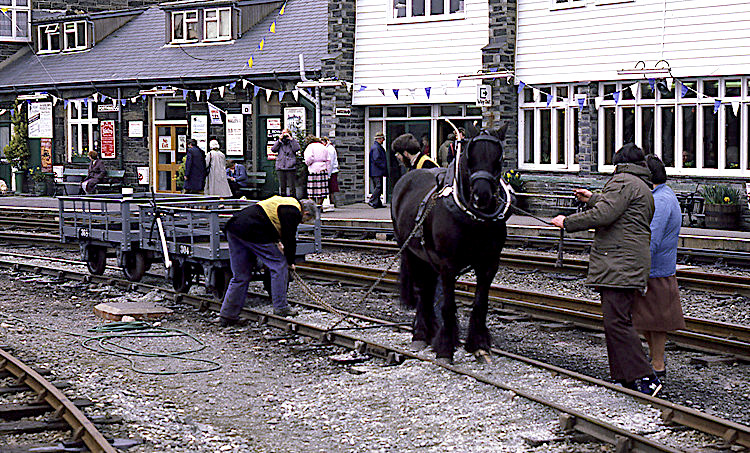
(This picture was taken in 1986 during the 150th celebrations of the Ffestiniog Railway.)
Gravity trains are still run on special occasions, with brakesmen sitting on the wagons to control their speed.
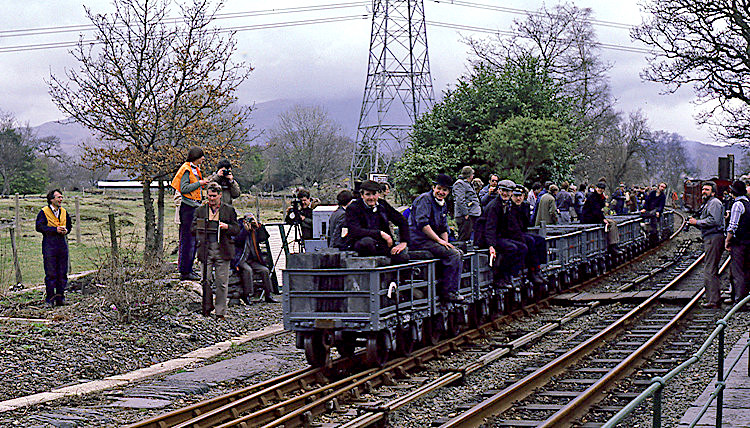
As slate traffic increased, horses were no longer able to cope with the hundreds of wagons. In 1856, Charles Easton Spooner, the son of James, looked at the use of steam locos. He asked for tenders to design a narrow gauge steam loco powerful enough to work the steep gradients and small enough to cope with the tight curves on the line. Contracts were signed with George England and Co for four locos. The Princess and Mountaineer were delivered in 1863, soon followed by The Prince and Palmerston.
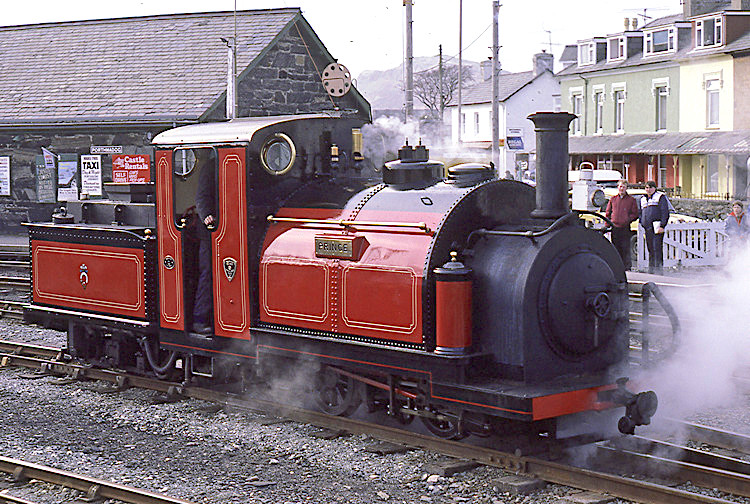
As well as slate, the trains now carried general goods. The Board of Trade gave the railway permission to run passenger services in 1864, the first on any narrow gauge railway.
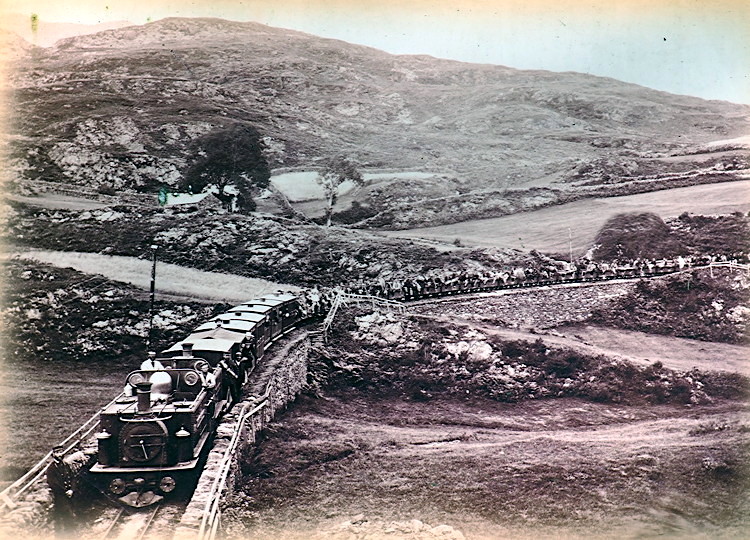
The first carriages were small four wheeled boxes used to carry quarrymen, often referred to a ‘bug boxes’. These were a wooden box with benches round the walls and small, open square windows. In the centre is the vacuum break, under a metal cover, which provides extra seating. There was no heating and no lights. It can’t have been very pleasant on a cold dark winter’s morning.
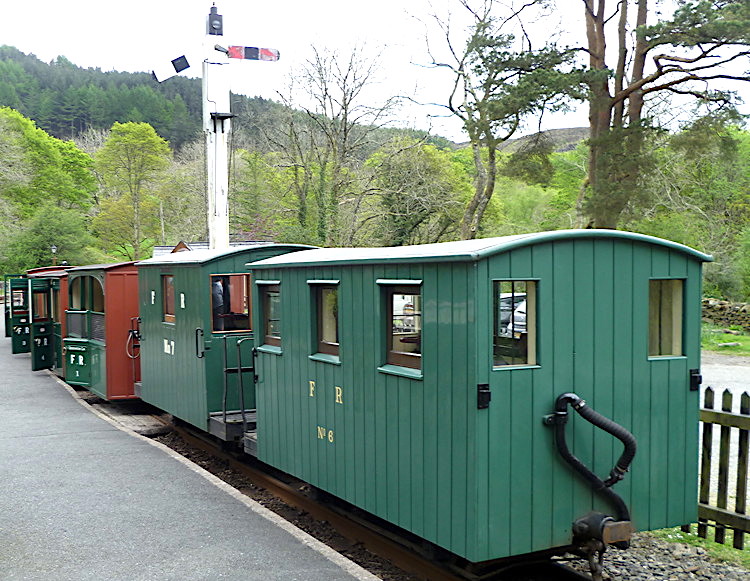
Slightly more comfortable coaches were provided for other passengers. They had a long wooden seat, described as a knife board bench along the length of the coach. Some have glazed windows, others are half glazed. A padded cushion provides a degree of comfort.
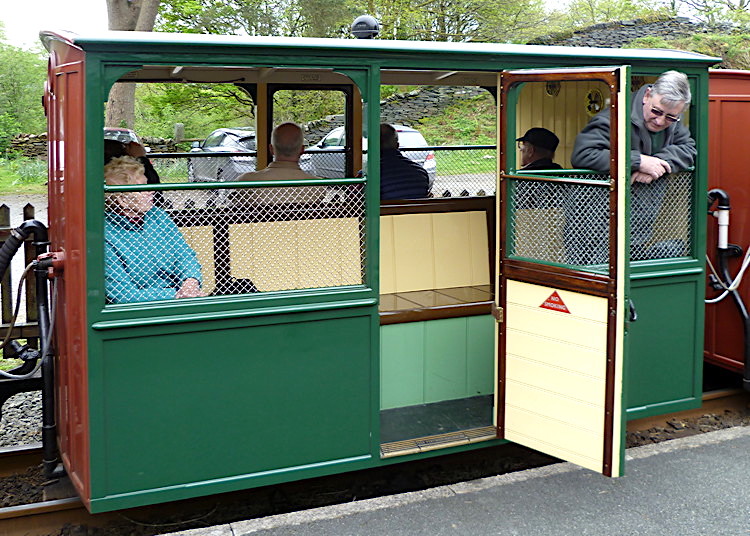
The observation coaches were similar but have a wire mesh across the opening rather than windows and a padded PVC seat.
There was also a totally open wagon, known as the flying bench, which has a leather apron across the front of the bench seat.
The break van had a wooden seat and can take a few passengers as well as luggage, push chairs and wheelchairs. It also has small square windows. The rear one gives good views back along the track, making you realise just how little clearance there is in places between coaches and the sides of cuttings.
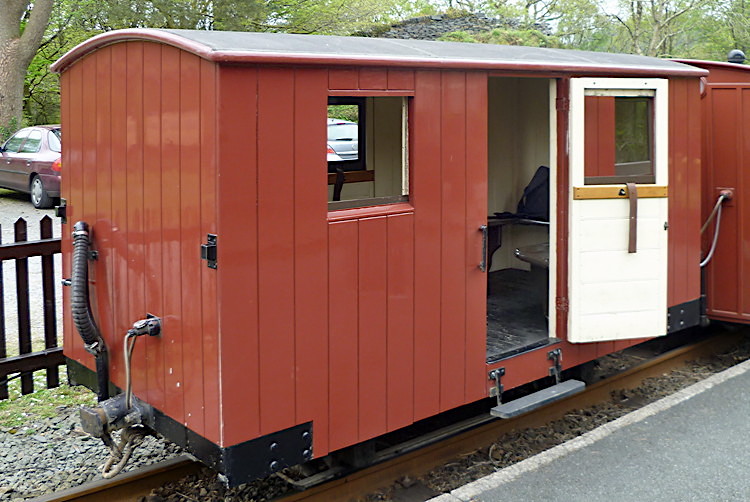
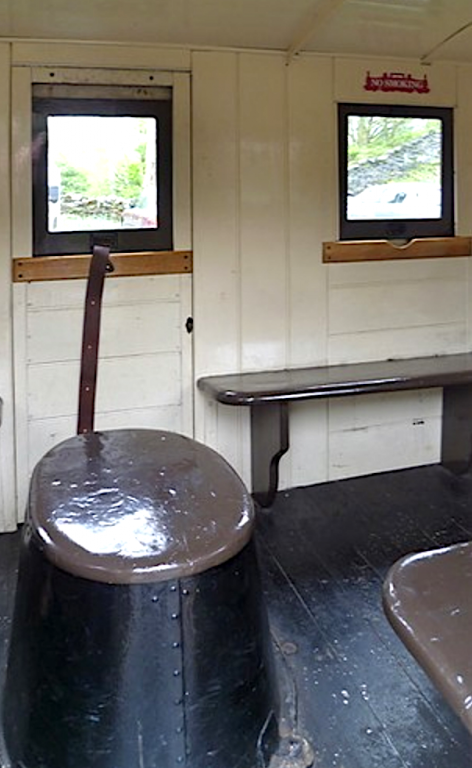
The railway still has some of these coaches which are run on special occasions and are affectionately referred to as ‘The Flying Flea’. Doors open outwards, so are locked by the guard before the train leaves to stop them flying open during the journey.
These were soon replaced by larger iron frame bogie coaches. The earliest coaches date from 1873 and the Ffestiniog Railway was the first railway in the World to use bogie carriages. Coaches have a central first class compartment with plush padded seats, giving a comfortable ride. Next to the first class are the second class compartments with upholstered bench seats and backs. At either end are the third class compartments. These originally just had wooden seats, but now have a cushion to give extra padding.
At the end is what is described as the curly roof van. This has guard’s compartment, luggage compartment and a small compartment for dogs.
Windows are opened and closed by thick leather straps. When shut, the window rests on a wooden ledge and they do rattle a lot during the journey. Compared with modern coaches, the windows are small and views restricted.
Some of these are still in use and look resplendent in their dark maroon and cream livery.
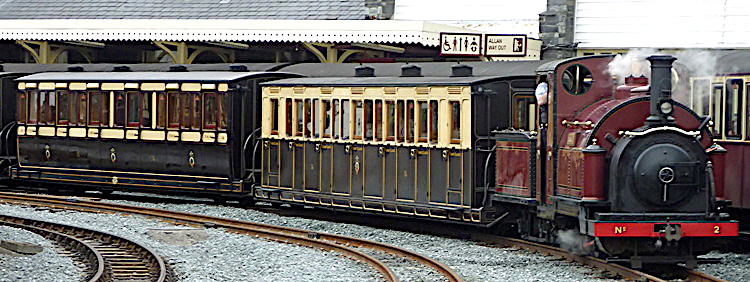
As traffic increased, the railway ordered two larger locos, Welsh Pony and Little Giant, but it was soon realised more drastic action was needed. An Act was passed to double the line but this would have been extremely expensive. The solution was the unique double Fairlie engine, designed by Robert Fairlie, with a single firebox and two boilers mounted on their own set of bogies. This allowed the locomotive to swing round tight curves and is the principle used in many modern diesel and electric locomotives.
Little Wonder was the first loco to be built and rapidly lived up to her name, having more than double the power of the earlier engines. The first train in September 1869 consisted of 111 slate wagons, 6 carriages, 60 passengers and 12 goods wagons. James Spooner soon followed. By now, Boston Lodge Works was a fully equipped workshop and Merrdin Emrys was built here in 1879, quickly followed by Livingston Thompson.
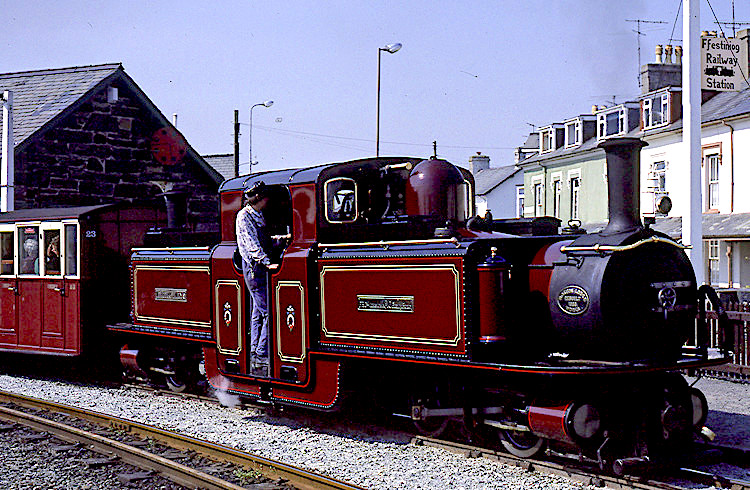
By 1872, coastal sea transport was being replaced by standard gauge railways. Exchange sidings were built at Minffordd for transhipment onto the Cambria Railway. The London and North Western Railway arrived in Blaenau Ffestiniog in 1879 quickly followed by the Great Western Railway to Minffordd and Pwllheli. Although they captured an increasing percentage of slate traffic, they also brought tourists to the area.
By the start of the C20th new roofing materials became popular. Linked with a series of disastrous strikes, the slate industry was in steep decline. Slate traffic plummeted. The railway was increasingly dependent on summer tourists, marketing itself as the ‘Toy Railway’.
Passenger and goods traffic continued to drop with the arrival of buses, lorries and the motor car after the First World War. Maintenance was poor and there were regular disruptions to the service. Passenger services were suspended at the outbreak of the Second World War, although some slate continued to be carried until 1946 when the line closed. The Act of Parliament needed to establish the railway had no provision for its closure, so everything was left where it stood.
Some of the pictures have been scanned from slides taken in the 1980s and 1990s, which explains the slight colour cast in some of them. Others were taken using a digital camera in 2019.
EARLY HISTORY
Some of the best roofing slate is found in North Wales. Originally this was carried by pack horses down to wharves on the River Dwyryd and then taken by boats downstream to be loaded into larger sea going sailing ships. Not only was this slow, it also resulted in a lot of broken slates.
At the start of the C19th, William Madocks, a local landowner planned to develop the area and improve its transport links with the rest of the world. This included the construction of a massive embankment called the Cob across the Glaslyn estuary. As well as reclaiming a large area of agricultural land this, it was hoped the cob would provide a direct transport link to Porthdinllaen, one of the proposed ferry terminals for Ireland.
It was a massive undertaking which bankrupt Madocks. Plans to develop Portdinllaen failed as Holyhead became the preferred route. However, the building of the Cob lead to the River Glaslyn scouring a natural harbour which was capable of handling sea going vessels. A settlement quickly grew up around the area named Port Madoc (later renamed Porthmadog).
Samuel Holland, a slate quarry owner realised the possibilities of shipping slate out of Port Madoc and, with Henry Archer, a young business man from Dublin, obtained an Act of Parliament for the construction of a railway from the slate quarries in the mountains above Blaenau Ffestiniog to the harbour. James Spooner was responsible for surveying and constructing the line.
The line was built to a gauge of 23.5” which was that used in the quarries. This was wide enough for horses to walk between the tracks and narrow enough to negotiate tight curves. The first slate trains ran in 1836. The line was carefully graded with cuttings and embankments so that loaded slate wagons would run down by gravity with horses riding in special dandy carriages. The horses pulled the loaded slate wagons across the Cob to the slate wharves and then pulled the empty wagons back to the quarries. The down trip took 90 minutes; the return trip nearly six hours.
(This picture was taken in 1986 during the 150th celebrations of the Ffestiniog Railway.)
Gravity trains are still run on special occasions, with brakesmen sitting on the wagons to control their speed.
As slate traffic increased, horses were no longer able to cope with the hundreds of wagons. In 1856, Charles Easton Spooner, the son of James, looked at the use of steam locos. He asked for tenders to design a narrow gauge steam loco powerful enough to work the steep gradients and small enough to cope with the tight curves on the line. Contracts were signed with George England and Co for four locos. The Princess and Mountaineer were delivered in 1863, soon followed by The Prince and Palmerston.
As well as slate, the trains now carried general goods. The Board of Trade gave the railway permission to run passenger services in 1864, the first on any narrow gauge railway.
The first carriages were small four wheeled boxes used to carry quarrymen, often referred to a ‘bug boxes’. These were a wooden box with benches round the walls and small, open square windows. In the centre is the vacuum break, under a metal cover, which provides extra seating. There was no heating and no lights. It can’t have been very pleasant on a cold dark winter’s morning.
Slightly more comfortable coaches were provided for other passengers. They had a long wooden seat, described as a knife board bench along the length of the coach. Some have glazed windows, others are half glazed. A padded cushion provides a degree of comfort.
The observation coaches were similar but have a wire mesh across the opening rather than windows and a padded PVC seat.
There was also a totally open wagon, known as the flying bench, which has a leather apron across the front of the bench seat.
The break van had a wooden seat and can take a few passengers as well as luggage, push chairs and wheelchairs. It also has small square windows. The rear one gives good views back along the track, making you realise just how little clearance there is in places between coaches and the sides of cuttings.
The railway still has some of these coaches which are run on special occasions and are affectionately referred to as ‘The Flying Flea’. Doors open outwards, so are locked by the guard before the train leaves to stop them flying open during the journey.
These were soon replaced by larger iron frame bogie coaches. The earliest coaches date from 1873 and the Ffestiniog Railway was the first railway in the World to use bogie carriages. Coaches have a central first class compartment with plush padded seats, giving a comfortable ride. Next to the first class are the second class compartments with upholstered bench seats and backs. At either end are the third class compartments. These originally just had wooden seats, but now have a cushion to give extra padding.
At the end is what is described as the curly roof van. This has guard’s compartment, luggage compartment and a small compartment for dogs.
Windows are opened and closed by thick leather straps. When shut, the window rests on a wooden ledge and they do rattle a lot during the journey. Compared with modern coaches, the windows are small and views restricted.
Some of these are still in use and look resplendent in their dark maroon and cream livery.
As traffic increased, the railway ordered two larger locos, Welsh Pony and Little Giant, but it was soon realised more drastic action was needed. An Act was passed to double the line but this would have been extremely expensive. The solution was the unique double Fairlie engine, designed by Robert Fairlie, with a single firebox and two boilers mounted on their own set of bogies. This allowed the locomotive to swing round tight curves and is the principle used in many modern diesel and electric locomotives.
Little Wonder was the first loco to be built and rapidly lived up to her name, having more than double the power of the earlier engines. The first train in September 1869 consisted of 111 slate wagons, 6 carriages, 60 passengers and 12 goods wagons. James Spooner soon followed. By now, Boston Lodge Works was a fully equipped workshop and Merrdin Emrys was built here in 1879, quickly followed by Livingston Thompson.
By 1872, coastal sea transport was being replaced by standard gauge railways. Exchange sidings were built at Minffordd for transhipment onto the Cambria Railway. The London and North Western Railway arrived in Blaenau Ffestiniog in 1879 quickly followed by the Great Western Railway to Minffordd and Pwllheli. Although they captured an increasing percentage of slate traffic, they also brought tourists to the area.
By the start of the C20th new roofing materials became popular. Linked with a series of disastrous strikes, the slate industry was in steep decline. Slate traffic plummeted. The railway was increasingly dependent on summer tourists, marketing itself as the ‘Toy Railway’.
Passenger and goods traffic continued to drop with the arrival of buses, lorries and the motor car after the First World War. Maintenance was poor and there were regular disruptions to the service. Passenger services were suspended at the outbreak of the Second World War, although some slate continued to be carried until 1946 when the line closed. The Act of Parliament needed to establish the railway had no provision for its closure, so everything was left where it stood.
Last edited:
